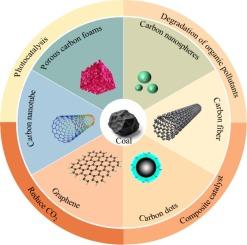Synthesis, functionalization and photocatalytic applications of coal-derived carbonaceous materials
IF 6
2区 工程技术
Q2 ENERGY & FUELS
引用次数: 0
Abstract
This article comprehensively reviews the latest advancements in coal-derived carbonaceous materials for photocatalytic applications. Contemporary research advancements have revealed the potential of coal-derived substances (including coal tar and gangue minerals) as precursor materials for synthesizing high-efficiency photocatalytic composites. These photon-mediated redox systems demonstrate versatile applications across three principal domains including environmental remediation, energy conversion technologies (CO2 photoconversion), and sophisticated organic synthesis processes. Modern materials engineering approaches employing advanced chemical functionalization and nanostructural modification techniques enable the transformation of carbonaceous matrices into hierarchically organized photocatalysts with optimized quantum yields and broad-spectrum responsiveness. This critical review provides a systematic analysis of fundamental mechanisms and contemporary developments in photocatalytic materials science, focusing on three key aspects: 1) Novel synthesis methods for coal-derived catalytic materials; 2) Performance optimization through crystalline defect engineering and heterostructure design; 3) Multiscale application mechanisms in integrated environmental-energy systems. Besides, the deep mechanism analysis confirmed by DFT calculations was also summarized. We further propose an integrative development paradigm combining resource circularity with sustainable manufacturing principles to advance next-generation photocatalyst innovation while promoting ecological transformation of traditional energy-intensive industries. The establishment of precise structure–activity correlations and the development of intelligent photocatalytic systems are highlighted as crucial research priorities for future technological breakthroughs in this field.

煤基碳质材料的合成、功能化及其光催化应用
本文综述了光催化用煤基碳质材料的最新研究进展。当代的研究进展揭示了煤衍生物质(包括煤焦油和脉石矿物)作为合成高效光催化复合材料的前驱体材料的潜力。这些光子介导的氧化还原系统在三个主要领域展示了广泛的应用,包括环境修复、能量转换技术(CO2光转换)和复杂的有机合成过程。现代材料工程方法采用先进的化学功能化和纳米结构修饰技术,使碳质基质转化为具有优化量子产率和广谱响应性的分层组织光催化剂。本综述系统分析了光催化材料科学的基本机制和当代发展,主要集中在三个关键方面:1)煤源催化材料的新合成方法;2)通过晶体缺陷工程和异质结构设计优化性能;3)环境-能源一体化系统的多尺度应用机制。此外,还总结了经DFT计算证实的深层机理分析。我们进一步提出了将资源循环与可持续制造原则相结合的一体化发展模式,以推动下一代光催化剂创新,同时促进传统能源密集型产业的生态转型。建立精确的构效关系和开发智能光催化系统是该领域未来技术突破的关键研究重点。
本文章由计算机程序翻译,如有差异,请以英文原文为准。
求助全文
约1分钟内获得全文
求助全文
来源期刊

Solar Energy
工程技术-能源与燃料
CiteScore
13.90
自引率
9.00%
发文量
0
审稿时长
47 days
期刊介绍:
Solar Energy welcomes manuscripts presenting information not previously published in journals on any aspect of solar energy research, development, application, measurement or policy. The term "solar energy" in this context includes the indirect uses such as wind energy and biomass
 求助内容:
求助内容: 应助结果提醒方式:
应助结果提醒方式:


